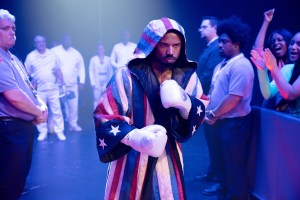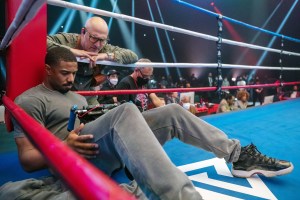Michael B. Jordan made his feature directorial debut with last spring’s Creed III, the third entry in the Rocky franchise spinoff that has proven a just as popular and powerful addition to the boxing classic’s cinematic legacy. With Jordan behind the camera as well as in front of it, this edition proved to be just as impactful and acclaimed as what came before.
Jordan, along with much of his crew artisans, joined me after a Deadline Virtual Screening Series showing of the film Thursday for a Q&A that included cinematographer Kramer Morgenthau, composer Joseph Shirley, editor Jess Baclesse, production designer Jahmin Assa and hair department head Elizabeth Robinson.

Michael B. Jordan in ‘Creed III’
Eli Ade / MGM /Courtesy Everett Collection
For Jordan, the time just seemed right to take on an even more hands-on creative approach to the series, and it was done with the blessing of the original director Ryan Coogler.
“I think it was a lot of different reasons why. It wasn’t just one thing,” Jordan said. “I think it started with Ryan Coogler, being able to see him start the franchise off and seeing somebody that looked like me, was close in age to myself, direct a major franchise like this gave me a little bit of that confidence, and we’ve had conversations around it with him saying ‘Mike, you got to jump behind the camera, eventually, and what better way to do it than with a movie like with this one?’
“Also, what played a huge part is that this is the only time I’ve played a character three times. I was very familiar with the character, the world, the family, and by the third time comes around as an actor, nobody kind of knows the character more than me, and I felt like it was the proper time to really take the Creed family in a direction that I saw it going in, and knowing that, I can assemble a team of people that I’ve already worked with before, that I had a shorthand with, especially [cinematographer] Kramer.
“You know I think Kramer played a huge part in that as well, just because this is like our fourth film that we’ve done together, and we’ve developed a chemistry that I knew he would have my back in a lot of ways, along with [producer] Irwin Winkler handing me the keys. This is something that has kind of been, with Sly Stallone and the Rocky franchise, and now the Creed movies, it’s a world that exists. So it took all those kind of things to kind of come together in a real way for me to feel really good about stepping behind the camera and telling the story.”
For Morgenthau’s part, he wanted to join Jordan in seeing how far they could take it, and that included the cameras. “I think Michael wanted to push this movie as far as he could go. You know it was his first time out as a director, and he just wanted to come out swinging, with all the tools in the toolbox, not just for the sake of using them but for kind of pushing the franchise and the genre to its absolute limit, sort of breaking out of the bounds of being in a movie that is in a franchise, a ninth in a franchise,” he said. “And you know, I think he wanted to make a stamp on it, and so, we used Imax cameras strictly for the boxing sequences, so they felt like you’re entering this different world, like a world of gladiators, or larger than life.”

(L-R) Michael B. Jordan and cinematographer Kramer Morgenthau on the set of ‘Creed III’
Eli Ade/MGM/Courtesy Everett Collection
Production designer Assa talked about the challenges of finding just the right locations in Atlanta, where the bulk of the film was shot (doubling for L.A.), and in the case of the home making it look like high-end Los Angeles. He also mentioned the fact that the daughter was deaf made some specific tasks even more pronounced, but added to the authenticity of the surroundings. Hair department head Robinson said that the look of the key women played by Tessa Thompson and Phylicia Rashad, as well as young actress Mila Davis-Kent, were a key part of the challenges she faced in getting just the right looks for the actors.
Film editor Baclesse explained how taking on the somewhat cliched sports movie trope of the montage sequence took on a different story-focused tone in Creed III. “It was something we worked on constantly. It went through many different versions, and it was just something that we kept working on. We kept trying new things. We kept checking all these different ideas, and what we realized most of all is you had to be emotionally connected with Adonis in that moment, and you had to understand where [opponent] Damian was coming from and what he was pushing for,” she said.
First-time feature composer Shirley talked about balancing a new direction for the series musically while also being reverential to what came before. “Creed III is the first step into a new direction for where this franchise is heading, and that’s how Michael envisioned it, and everybody was working towards that goal,” he said. “So, now that we don’t have Sylvester Stallone in this particular movie, we needed to be self-referential to other Creed movies, as opposed to maybe more the Rocky musical fanfares, and whatnot. We did reference [Rocky composer] Bill Conti at the end of the final fight, in a really, I would say, poignant sort of way, because you’ve got to sort of have that. It’s this conditioned response, but you want it, and you need it, and having that really special Bill Conti going the distance theme did mean a lot, to us, at the end of that final fight.”
Click on the video above to watch the panel conversation.

